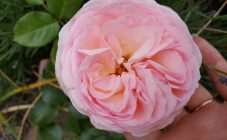Content:
The Pomponella rose variety is one of the most beautiful varieties of roses, undoubtedly worthy of attention. Many flower growers around the world have made this rose a "inhabitant" of their gardens. Due to its unusual shape and color, the Pomponella rose is perfect for creating landscaping.
History of creation
This variety was developed by one of the world's most famous rose breeding and production companies - W. Kordes & Sons ". This variety belongs to the Floribunda class, which means "profusely blooming".
Pomponella is a relatively recent rose. A little less than 15 years have passed since her birth (2005). During this time, she managed to win awards and prizes at many exhibitions in Germany, the Netherlands, France, Switzerland and Belgium.
Having appeared in 2005, the rose passed certification a year later, receiving the ADR quality mark.
Characteristics and features of the variety
The Pomponella rose variety differs from the rest in its characteristics and characteristics of cultivation and care.
Frost resistance
According to the Department of Agriculture of America - the limit of resistance to low temperatures in a rose is high: up to -20 degrees.
Despite this, the plant should be covered for the winter. It is imperative to hilling. Before covering the rose, it is necessary to remove the shoots, loosen the topsoil to better provide oxygen to the root system of the flower.
Yield
The variety has a good yield. Immediately, in the first year, the rose bush grows up to 185 cm, delighting with many double dark pink flowers.
Bloom
The amazingly beautiful double flowers immediately attract attention. They differ from the usual form of roses in that for a long time before the buds bloom, they are in the form of peonies. It looks amazing.
Each bud has 80-85 petals. The diameter of each flower is small - only 4-5 cm. Up to 15 buds fit on one stem.
Pomponella boasts a long flowering time: the process begins in late spring and ends in early autumn. During the flowering period, it emits a delicate, unobtrusive aroma.
Parameters
The Pomponella floribunda rose is a lush bush dotted with abundant deep pink flowers. The foliage is juicy, dark green. Plant height varies from 70 cm to 1 m 85 cm.The width also varies in size from 60 cm to 1 m 60 cm.
Planting, growing and caring for a plant
Rose Floribunda Pomponella is unpretentious and does not require excessive care. She does not need "greenhouse" conditions. It can grow in most regions of Russia. Nevertheless, a florist needs to know how to plant and grow a plant correctly, what should be the care.
Landing
The first important condition is to choose a suitable place for the plant. It should be simultaneously viewed so that you can admire the roses, on the other hand - well protected from strong winds.
Pomponella requires a lot of sunlight. This should also be taken into account when choosing a landing site. The ideal option is the sun's rays in the morning and evening.
Lowlands won't do. There is stagnation of air masses. Roses can start to hurt.
Priming
Chernozems are the best land option for growing the Pomponella variety. Loamy soil is also fine, but in this case it is recommended to use organic fertilizers.
The acidity of the earth should be slightly acidified. To achieve the desired soil pH, it is enough to add peat to the soil. Excessive acidity can be eliminated by adding lime, ash.
Planting process of Pomponella:
- Dig a hole 60 cm deep. Line the bottom with drainage more than 10 cm thick. You can use crushed stone, small stones.
- Be sure to add an organic nutrient, mix with the soil.
- Pour a layer of soil 10 cm thick on top.
- Dip the roots of the rose before planting in the prepared mixture of water and earth, maintain for 10 minutes.
- Plant in open soil and carry out root watering.
- When the earth subsides - sprinkle a little more soil. Add peat on top.
Care
Timely soil loosening, weeding, regular fertilization, pruning are necessary. In the spring, nitrogenous fertilizers are applied to the soil, in the summer - phosphorus and potassium. The flowers are tolerant of dry periods, however, they should be watered in sufficient quantities during this time. Young plants especially require moistening the earth.
Pruning
Timely pruning is required for rose bushes. Most often, it is done in the spring. There are several options for performing this procedure. They are used depending on the desired result.
A flower lover must decide which is more important: a specific plant shape or flowering. Based on this, a strong, medium, weak pruning is carried out.
- Strong is used to rejuvenate the plant.
- Medium - allows you to achieve flowering, beautiful decorative appearance.
- Weak is used for harvesting already faded buds.
Professionals in planting and growing roses often turn to the combined method: it combines the techniques of different pruning. Skillfully wielding these methods, they achieve the incessant flowering of the plant throughout the year.
An example of a pruning plan:
- 1st year - shorten the shoots 15-20 cm from the soil surface. Remove the weak. Non-flowering - cut off, pinch the stems a little.
- 2nd year - in early spring, free the bush from sick, weak branches. Old ones - cut by 15-20 cm, as in the first year. In the coming of autumn, pinch the main flowering shoots. Cut off non-blooming.
- 3rd year and the rest - in the spring, also clear the bush of sick, weak branches. Cut annual shoots by one third. On the sides - remove up to 15 cm. Thin the middle if necessary.
The last time before Pomponella's shelter is the beginning of winter, in December. Before that, the bush must be hilled, pressing the stems to the ground after hilling. Be sure to secure them. Use burlap or spruce branches for cover.
Reproduction
At home, they use the simplest method of propagation while maintaining varietal characteristics - cuttings.
Below is a step-by-step description of the reproduction of the Pomponella rose:
- The size of the handle should be as follows: the width is the same as that of a simple pencil, the length is 8 cm.
- You need to make a cut half a centimeter above the kidney.
- The top cut should be made at a 90 degree angle, the bottom cut at a 45 degree angle.
- Be sure to remove all leaves and thorns from the trunk.
- Apply a growth stimulator for better rooting, plant the cuttings in fertile soil.
Some flower lovers suggest growing new roses using potatoes. The essence of the method is that the stem of a flower is inserted into an ordinary medium-sized potato. For a certain time, the vegetable tuber will supply the cutting with nutrients and moisture.This time is enough for the stalk to sprout. Then it can be planted in a pot.
Advantages and disadvantages
The Pomponella rose variety is relatively young and already in great demand among gardeners.
Among the main advantages of culture are:
- bright, juicy dark pink shade of flowers;
- an interesting peony shape, which lasts for a long time until the flower is fully opened;
- excellent decorative qualities that allow you to use the rose to decorate any landscape;
- recurring flowering (experienced flower growers can achieve year-round flowering);
- endurance, frost resistance;
- resistance to pests, diseases;
- a huge number of shoots.
There are also disadvantages inherent in this plant variety. Burns are characteristic of petals; in the strong sun, roses can burn. Therefore, you should carefully choose a landing site. For areas with dry and hot climates, it is better to exclude planting a flower in an open area.
Rose Floribunda Pomponella is a great choice for decorating your garden. An unpretentious plant in care is able to delight with its lush flowering for almost a whole year. When planting and growing, certain conditions must be observed. It is necessary to ensure timely watering and fertilization of the soil.

















